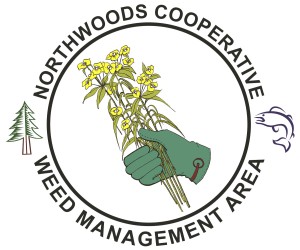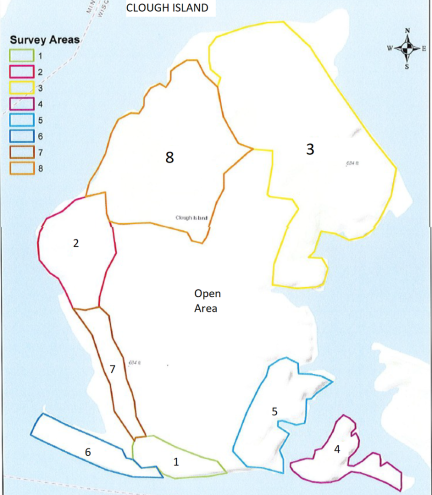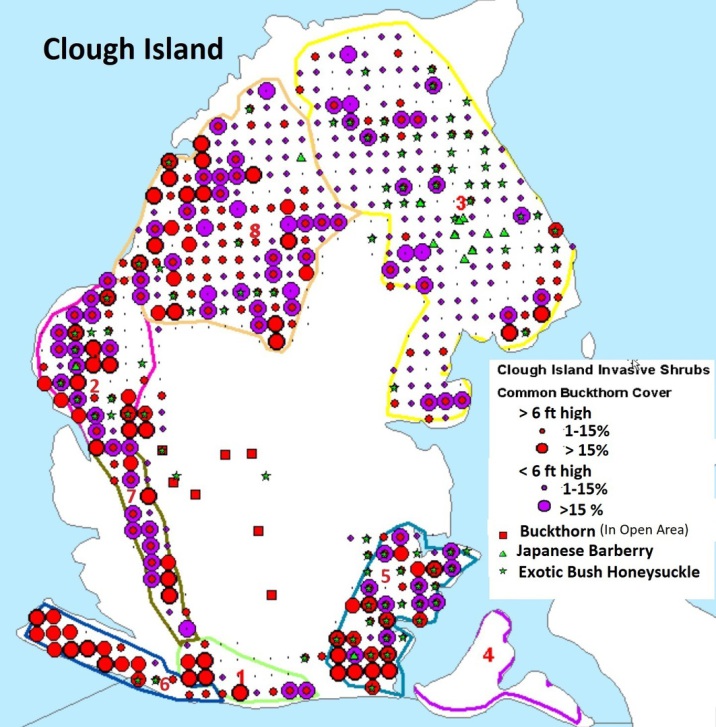Managing Common Buckthorn on Clough Island
In 2019, the Wisconsin Department of Natural Resources (WDR) received a Great Lakes Restoration Initiative (GLRI) grant to treat buckthorn on Clough Island, which is an island of over 350 acres that sits between Duluth and Superior in the St. Louis River. The grant will fund five years of annual large-scale herbicide treatments of common buckthorn which has infested most forested areas of the island. To manage buckthorn, treatments must be repeated annually over multiple years. The Northwoods Cooperative Weed Management Area (NCWMA), in cooperation with the WDNR, will assist with the project by organizing work events each fall that bring people to the island to control buckthorn and make them more aware of this unique publicly-owned island. (Anyone interested in taking part in such events should contact the NCWMA.)
The reason that Clough Island is so infested with buckthorn can be traced back to the early 1900s. In those days, Clough Island had a dairy and sheep farm. The farm was most active in the first few decades of the century. Its buildings were constructed, forests were logged, a large field was cleared for grazing and racing horses, and evidently many landscaping plants were planted. Buckthorn was often used for hedges in the early 1900s.
After the farmhouse burned down in 1956, the island had little human activity, which allowed invasive plants to spread freely. As the island passed from one landowner to another, there were plans for hotels, a golf course and other developments. However, an effort was made to protect the land from development and in 2010 the Nature Conservancy purchased the land from developers and donated it to the Wisconsin Department of Natural Resources (WDNR) in 2011. The WDNR has a goal of restoring the island to its historic forest cover. Controlling the buckthorn is an important component of restoration efforts. In 2013-2015, the WDNR surveyed the property, treated areas with buckthorn, and planted trees. The farmhouse and buildings were situated in Region 5 in the southeast section of the island (See map to the left).
The NCWMA assisted in surveying for common buckthorn in the fall of 2019 so that the WDNR can make a buckthorn treatment plan with the new funding. Using hand-held GPS devices, surveyors visited points in a grid of 40 meter spaced points within the forested regions. Information on the habitat and buckthorn density over 6 feet and under 6 feet tall was recorded. Surveys found that quaking aspen and paper birch are the dominant trees found in forested plots across Clough Island. The northern two regions (3 and 8) have more tree diversity with 25% of forested plots dominated by a mix of deciduous trees and conifers including white spruce, Eastern white cedar, balsam fir, and a pockets of red pine.
Although common buckthorn is in the forests throughout Clough Island, the invasive shrub is less dense in the northern regions of the island (right-Region 8) than the southern half of the island (left-Region 6).
Common buckthorn (Rhamnus cathartica) was found throughout the forested areas of the island, with 76% of plots having common buckthorn present. The map below shows the percent cover of buckthorn found in plot surveys that were over 6 feet (in yellow) and less than 6 feet (in purple). The buckthorn is especially dense in the southern half of the island where the farm was located. The northern two regions (8 and 3) had the lowest density of buckthorn. Region 3 in particular is the least impacted by buckthorn with an average cover of buckthorn of less than 5%.
There are pockets of buckthorn and honeysuckle patches in the large open area in the center of the island, which was the old farm field. This area wasn’t surveyed, but patches of invasive species were mapped when encountered. Japanese barberry and exotic bush honeysuckle plants were also found throughout the island, but at a much lower density than buckthorn.
Five years of persistent treatments of buckthorn should make a substantial impact on the density of buckthorn on Clough Island. With time and consistent efforts, the island will not only be a sanctuary for humans and wildlife from the nearby city, but also a beautiful example of habitat restoration.





